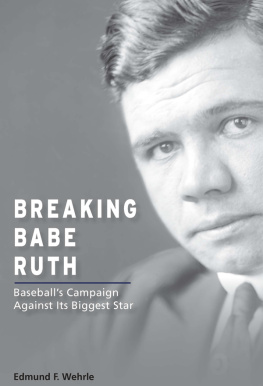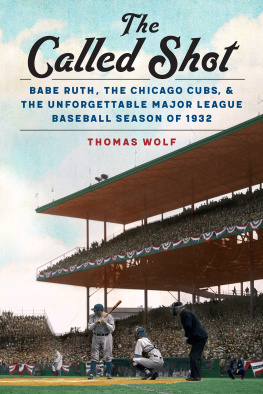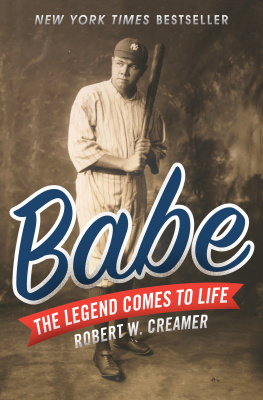BREAKING BABE RUTH
Copyright 2018 by
The Curators of the University of Missouri
University of Missouri Press, Columbia, Missouri 65211
Printed and bound in the United States of America
All rights reserved. First printing, 2018.
Library of Congress Cataloging-in-Publication Data
Names: Wehrle, Edmund F., 1964- author.
Title: Breaking Babe Ruth : baseballs campaign against its biggest star / by Edmund F. Wehrle.
Description: Columbia : University of Missouri, 2018. | Series: Sports and American culture | Includes bibliographical references and index. | Identifiers: LCCN 2017052792 (print) | LCCN 2017060404 (ebook) | ISBN 9780826274090 (e-book) | ISBN 9780826221605 (hardback : alk. paper)
Subjects: LCSH: Ruth, Babe, 1895-1948. | Baseball--United States--History--20th century. | Major League Baseball (Organization)--History--20th century. | Baseball players--United States--Biography. | BISAC: SPORTS & RECREATION / Baseball / History.
Classification: LCC GV865.R8 (ebook) | LCC GV865.R8 W38 2018 (print) | DDC 796.357092 [B] --dc23
LC record available at https://lccn.loc.gov/2017052792
 This paper meets the requirements of the American National Standard for Permanence of Paper for Printed Library Materials, Z39.48, 1984.
This paper meets the requirements of the American National Standard for Permanence of Paper for Printed Library Materials, Z39.48, 1984.
Typefaces: Frutiger and Minion
contains a revised version of Frenzy: Babe Ruths Much Ballyhooed Premier Season with the New York Yankees, NINE: A Journal of Baseball History and Culture 23, no. 2, (Spring 2015): 6883, reprinted with permission of the University of Nebraska Press.
Sports and American Culture
Adam Criblez, Series Editor

This series explores the cultural dynamic between competitive athletics and society, the many ways in which sports shape the lives of Americans, in the United States and Latin America, from a historical and contemporary perspective. While international in scope, the series includes titles of regional interest to Missouri and the Midwest. Topics in the series range from studies of a single game, event, or season to histories of teams and programs, as well as biographical narratives of athletes, coaches, owners, journalists, and broadcasters.
For my babes, Annabel and Josephina.
ACKNOWLEDGMENTS
A PROJECT THIS SIZE and scope inescapably becomes something of a team effort, to use the inevitable sports metaphor. I owe much to the people and institutions that made up my team. Eastern Illinois University (EIU), where I have taught for nearly two decades, provided valuable institutional support, particularly in the form of a summer research grant and reassigned time. I relied heavily on the outstanding staff at EIUs Booth Library. Jana Aydt deserves special thanks for her resourcefulness in procuring materials for me from across the country. My colleagues in the History Department also provided valuable support. Special thanks to Lynne Curry, Martin Hardeman, and Debra Reid (now at the Henry Ford Museum), all of whom offered encouragement and trenchant insights.
This study also owes a debt to the fine librarians and staff at the National Baseball Library in Cooperstown, New York, at the Library of Congresss Manuscript Division and Newspaper Reading Room, and at the Milstein Microform Reading Room at the New York Public Library. As a scholar teaching a relatively heavy load at a rural state university in the Midwest, I am endlessly grateful for the growing collection of digitized newspapers and materials increasingly available online. The Brooklyn Public Librarys digitized archive of the Brooklyn Daily Eagle, the Library of Congresss Chronicling America digitized newspaper collection, and Google News Archives (although more limited in its search capacities) were all godsends, allowing me to conduct research from my office between classes.
In the final stages of this project, Andrew J. Davidson, the editor in chief at the University of Missouri Press, proved a model of patience, wise counsel, and professionalism. He skillfully steered my manuscript to thoughtfulreaders and then expedited its publication. Mary Conley, assistant acquisitions editor at UMP, also provided prompt and valued help as this project neared completion. Dr. Adam Criblez, editor of the UMPs Sports and American Culture Series, carefully reviewed my manuscript and provided insightful commentary. My thanks as well to Amy Maddox, who patiently provided invaluable copyediting as the manuscript neared completion. Finally my wife, Jacqueline Wehrle, a professional editor, gave freely of her valuable time to review and comment on chapters, correct footnotes, and polish and proof the final manuscript. Words can never express my gratitude to her.
Suffice it to say, this book could not have been written without my winning team. Responsibility for its shortcomings and limitations, however, falls squarely on my own shoulders.
INTRODUCTION
IN 1959, THE eminent sports journalist Red Smith informed his readers how an entire class of young students rose up against a teacher who dared assert Babe Ruth had the mentality of an eight-year-old. To the youngsters, Ruth was an inspiration and an icon. The very notion that he was anything less outraged the class. The teacher may have been misinformed, though in that she isnt alone, explained Smith. Many, the columnist acknowledged, remember Ruth as something of a dolt off the baseball diamond. True, Ruth was unschooled, unpolished, profane, widely uninformed, rowdy... but he was in no sense stupid. Smith aimed to defend Ruth, but a reader could hardly be blamed for finding the column something less than a vigorous defense of Ruths intellect.
Even today, more than a century after his birth, impressions of Babe Ruth, baseballs greatest hitter and biggest personality, remain perplexingly bifurcated. None doubt his prowess as an athlete, in particular his amazing capacity to hit home runs. Mention of Ruth immediately conjures up jumpy black-and-white film footage of a pudgy powerhouse launching stratospheric home runs, then clicking around the bases on spindly legs. His warm smile and memorable moon face remain instilled in American iconography. Yet we also have inherited other, less flattering impressions. Most recall a player who challenged authority, defied Prohibition, reveled with abandon, and womanized recklessly. If Americans went on a postwar bender during the 1920s, Ruth, in popular memory, hosted the festivities. The gluttonous side of Ruth persists very much as part of our public memory. The Babe might not quite have possessed a dark side, but, as his nickname suggests, his maturity remains an open question.
This study seeks to place Ruths career in full context. It situates his story within the larger framework of baseball, sports, culture, and society during Ruths reign. Popular impressions of the baseball hero, I argue, hardly emerged organically. Rather, they were consciously constructed and manipulated by the baseball establishmentin particular, club owners, league officials, and sportswriterswho viewed Ruth simultaneously as a savior and an existential threat. The Babe excited and inspired fans as no other baseball figure had, yet his independent streak and outspokenness gravely troubled elites at the helm of professional baseball. It was essential that the peril Ruth posed be checked, while his potential be exploited. Hence the split image of Ruth has passed down to us even today. For baseball writers, club owners, and league officials, the retort to the Ruthian dilemma was to contain, to infantilize, and ultimately to break the superstar player.








 This paper meets the requirements of the American National Standard for Permanence of Paper for Printed Library Materials, Z39.48, 1984.
This paper meets the requirements of the American National Standard for Permanence of Paper for Printed Library Materials, Z39.48, 1984.